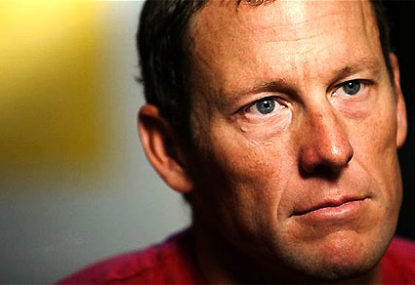'I've just won a stage of the Tour de France, mate!': Hindley grabs yellow jersey as Aussie blows Tour apart
Australia's Jai Hindley has said he is "lost for words" after a shock stage victory at the Tour de France earned him the leader's…

The Livestrong cap should have tipped me off, but I wasn’t concentrating. I was too busy peering up the road, searching for the lights of the lead car through the gloom of a miserably windy and cold Victorian afternoon.
Of the smattering of spectators leaning against the road barriers, the cap wearer had positioned himself next to me. By the way he was hovering and throwing glances my way I just knew he was itching for a chat.
“You got a girl racing, mate?” he asked eventually.
It was a fair question as we were standing at the finish line of Stage 3 of the Tour of the Goldfields, the final women’s National Road Series race of the year.
Apart from an SBS film crew and the sports editor of the local newspaper, the rest of the small crowd was made up of team managers and family members.
“No, just an interested observer,” I replied.
He pressed me further and I admitted that I did a bit of sports writing on the side and had come out hoping to interview some of the riders after the event.
“Ah, a blogger!” he said, eyes lighting up, “I was reading on a blog the other day about how LeMond said Armstrong wouldn’t have finished in the top 30 of the Tour de France if he hadn’t been on drugs.”
There was some movement at the end of the road, a vehicle with flashing lights had rounded the corner and was coming our way.
“There may be some truth in that,” I replied absently, leaning out over the barrier trying to see if the peloton was coming.
“LeMond is just jealous that Armstrong won more Tours than him,” came the snorted retort.
I looked at my companion for the first time, finally noticing the Livestrong cap.
“LeMond didn’t start complaining until after Lance beat his record of three wins,” he continued. “I don’t care what they say, I still wear my wrist band.”
At that he pushed up his sleeve to reveal the distinctive yellow band that encircled his wrist. The jumper he wore also featured the Livestrong brand, as did his tracksuit pants. He then lifted one of his legs to point out his Livestrong socks, before unzipping the top of his jumper to show me his Livestrong t-shirt.
Over the next few minutes he regaled me with Lance propaganda.
It was like listening to the mighty Armstrong publicity machine of the past as it attempted to bulldoze its way over the accusers and truth seekers in a bid to preserve the reputation of its larger-than-life figurehead.
It was all there; the change in body shape after cancer that turned him into a stage racing supremo, the bitterness of LeMond, the fact that he’d won a world championship pre-cancer.
Right through to the last desperate cries of ‘well everyone was doing it anyway.’
I looked at the tall young man before me, and wondered how old he would have been when Armstrong first ‘won’ the Tour de France in 1999. He would have been barely out of nappies, definitely not yet out of primary school.
So perhaps he’d been dazzled by Armstrong’s later ‘victories’, perhaps caught up in the Texan’s historic seventh Tour win as an impressionable teen, or been captivated by the heroic tales of survival in Armstrong’s best selling book, ‘It’s not about the Bike’.
And yet he knew his cycling history, however skewed his take on the last 15 years was. He knew all about LeMond, his battles with Hinault and Fignon and his accidental shooting.
He could rattle off dates and events as if he had been following the races of Europe for years.
In his own way he was an impressive individual, and I admired his courage for standing up for his fallen idol and for so publicly displaying his undying allegiance, however different his opinions may have been from mine.
It takes real guts to come to a bike race these days completely kitted up in Livestrong gear, although I had to chuckle when he said he got a lot of the stuff ‘on sale’.
But as courageous or sad as it appears, it is just one example of how Armstrong pulled people to the sport of cycling. His name might be mud now, but his influence lives on, especially among those who were drawn to the sport because of his exploits.
The young Armstrong fan at the Tour of the Goldfields was obviously a cycling fanatic. He was attending an event that, with no disrespect to the National Road Series or women’s racing, was decidedly low profile.
And yet there he was, out on a blowy, overcast day, with only a handful of others, throwing his support behind the event. You can’t criticise him for that.
But if it hadn’t been for Armstrong, he wouldn’t have been there at all.